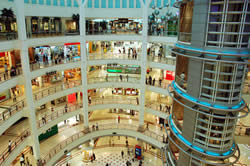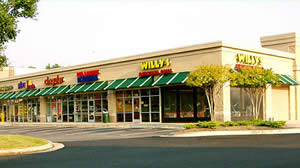Difference between Mall and Shopping Center
Key Difference: Shopping malls or malls are large enclosed spaces that are often characterized with many stores that sell merchandise to the public. Malls can be medium to large in size, depending on the construction and the number of stores that it wants to hold. Shopping centers are stores that are arranged in a row and share a building. These stores are connected to each other, but do not have a centralized internal access for the public. The stores share a building and may even share a parking lot in the front.
Malls and shopping centers are two words that are interchangeable as they refer to the same thing for many people. These two words both refer to a large space that allows a person access to more than one store. Though shopping malls are often referred to as shopping centers, many will argue that there is a slight difference. Shopping centers are used to refer to strip malls. These are open-air shopping mall, which means though they are housed in the same building they require you to exit one store before entering another. On the other hand, malls allow internal access to all the shops.
 Shopping malls or malls are large enclosed spaces that are often characterized with many stores that sell merchandise to the public. These places are also referred to as shopping arcade or shopping precinct. Malls can be medium to large in size, depending on the construction and the number of stores that it wants to hold. Shopping centers usually refer to smaller malls, while shopping malls are used to refer to the large shopping areas. The malls are enclosed and have centralized cooling or heating, depending on the weather and the area where the mall is located. Malls are also car-friendly and are associated with having large parking spaces in an underground parking lot or an adjoining building. The malls also have many different stores that sell many different kinds of merchandise, including food, jewelry, clothes, specialized stores, watches, etc.
Shopping malls or malls are large enclosed spaces that are often characterized with many stores that sell merchandise to the public. These places are also referred to as shopping arcade or shopping precinct. Malls can be medium to large in size, depending on the construction and the number of stores that it wants to hold. Shopping centers usually refer to smaller malls, while shopping malls are used to refer to the large shopping areas. The malls are enclosed and have centralized cooling or heating, depending on the weather and the area where the mall is located. Malls are also car-friendly and are associated with having large parking spaces in an underground parking lot or an adjoining building. The malls also have many different stores that sell many different kinds of merchandise, including food, jewelry, clothes, specialized stores, watches, etc.
The concept of the mall has not been a new one; they have been around since Ancient Rome. The concept itself has been acquired from the Trajan's Market that was one of the earliest shopping centers that established in Rome. Rome’s are also known for its many bazaars, which eventually developed to shopping malls. The malls gained popularity around the 1920s, following World War II, when people started shifting to the suburbs from the city. In order to make it easier for the people to shop, many stores were opened in one bigger store that allowed easier access to the various stores in the same place.
The malls have a variety of branded and local based stores. The prices of the stores also vary depending on the type of the store; while branded stores are quite pricy; other smaller stores offer normal prices on merchandise. Malls are also associated with having food courts, movie theatres, play area and many other attractions to draw in the public. A few malls, such as the Mall of America in Bloomington, Minnesota, have also housed an amusement park inside to mall itself. Malls are quite large and require a lot of time to try and visit every store. They have elevators, escalators, stairs and walkways to help the public get around from one place to another. There are various different kinds of malls: Neighborhood center, Community center, Regional center, Superregional center, Fashion/specialty center, Power center, Theme/festival center and outlet center. Another feature of the mall is that they cannot conduct sales online, they must have a proper outlet; though they can have their own websites that state upcoming events, the number of stores or a list of the stores they have, etc.
 Shopping centers are stores that are arranged in a row and share a building. These stores are connected to each other, but do not have a centralized internal access for the public. The stores share a building and may even share a parking lot in the front. They have stores in the front, while loading docks in the back. Shopping centers are also known as strip malls or open-air malls. Shopping centers are quite similar to malls, one of the reason they are often confused with a mall but have slight differences. Shopping centers do now allow an enclosed area for the public. This means that there is no connected pathway that allows access to the all the stores from one place. The person would have to exit one store to enter another. The pathways are also not fully covered and may offer a shade such as a hallway. Shopping centers also do not have large stores to attract the public.
Shopping centers are stores that are arranged in a row and share a building. These stores are connected to each other, but do not have a centralized internal access for the public. The stores share a building and may even share a parking lot in the front. They have stores in the front, while loading docks in the back. Shopping centers are also known as strip malls or open-air malls. Shopping centers are quite similar to malls, one of the reason they are often confused with a mall but have slight differences. Shopping centers do now allow an enclosed area for the public. This means that there is no connected pathway that allows access to the all the stores from one place. The person would have to exit one store to enter another. The pathways are also not fully covered and may offer a shade such as a hallway. Shopping centers also do not have large stores to attract the public.
The centers also do not offer additional activities such as gaming area, play area, amusement park, etc. Shopping centers also do not have a food court, though they may share the parking lot with food kiosks. There may also be a select food store, depending if the store is leased by that food company. For example, in the middle of all the clothing stores, Subway Sandwich may have leased a store to offer food for the public. Shopping centers usually house small supermarkets, video rental stores, dry cleaning, grocery stores, coffee shops, etc. The first shopping centers have been dated back to ancient Europe, when they would have covered bazaars.
Many state that shopping centers are open-malls, while closed shopping centers are shopping malls. There is not clear definition to the term ‘shopping center’ it has been evolved from everyday speech. However, some people use the difference above to distinguish between the two.
Image Courtesy: prodryers.com, bbs.beastieboys.com









Add new comment